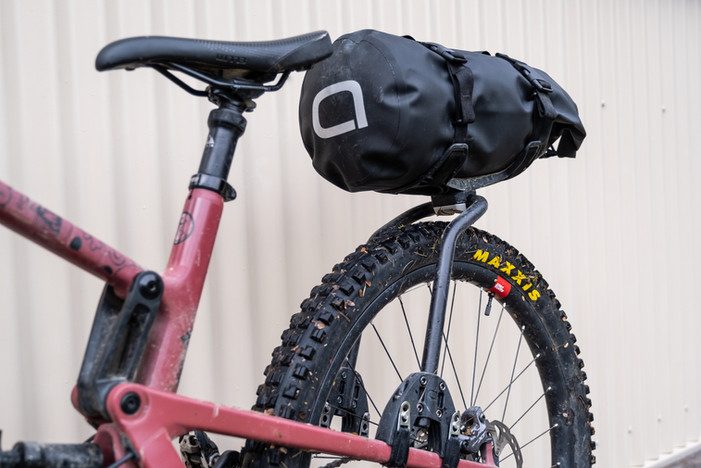Review by Odin Woods
RRP: $199
Find out more here.
“The Spider Rack system is comprised of a rear rack, rear cradles, front cradle, and some nice dry bag options to suit just about every bikepacking pursuit.”
When I think bikepacking, I think of drop bars, janky bags and loose straps hanging off every corner of the bike.
Some of those janky seat bags, front rolls and frame bags have become more refined over the years – to stop stuff bouncing, swaying, and ultimately falling off your bike – but there still isn’t the perfect solution for all occasions by any means. Consumers pushing for cleaner, simpler, less faffy ways of mounting bags on bikes continues to drive innovation. Innovators, like brothers Mike and Paddy Maguire at Aeroe, have certainly played their part in that move. You can thank them for the original freeload rack (now sold by Thule) – which I’m sure many of you have seen over the years – and now for the Aeroe Spider Rack system. The Spider Rack system is comprised of a rear rack, rear cradles, front cradle, and some nice dry bag options to suit just about every bikepacking pursuit. All the parts have a very modular feel about them, and you can tell each component has had a lot of love poured into it, design-wise, allowing for a very simple and easy-to-use product.
I’m kind of a ‘rip the packaging open first, read the instructions later’ person, and if how something is supposed to work isn’t immediately apparent then, in my opinion, it isn’t effortless for the customer. I applied this logic when first fitting the rear rack to my gravel bike and was quickly impressed with how simple and easily adjustable everything was. The mounting brackets can rotate to accommodate different seat stay angles and the rack itself can flex to achieve different widths. The rack height can also be adjusted +/- 30mm by loosening the four bolts and sliding it up and down through the mount to adjust the clearance around the rear tire. Nipping up the 5mm Allen key, the Silicone coated straps effortlessly tension up to keep the rack secure, without risking damage to your frame.


“I more or less forgot that there was a 12L dry bag strapped to the back of my bike. The rack was rock solid and didn’t make a sound.”
I pulled it off and within three minutes had it mounted on my Santa Cruz 5010. I chose to flip the entire rack 180° so the cradle sat back a bit further and lower down to clear my seat on compression. Aeroe note this as a ‘hot tip’ in their install guide.
It was time to put this stuff to use! We gapped it out of town to a quiet wee hut for the night and opted to use the Spider rear rack, with a single cradle, and the 12L dry bag to hump our gear up-river to the night’s accommodation. It was a quick transition in the pouring rain from empty bike to loaded bike. We simply clicked the cradle’s integrated buckles over the dry bag, then we were off. Jordan opted to mount his rack facing back as well, and had plenty of clearance over a 29er rear wheel as we bounced our way across tussock, river lands and the beech forest beyond. Without the usual constant swaying of a loaded seat bag, I more or less forgot that there was a 12L dry bag strapped to the back of my bike. The rack was rock solid and didn’t make a sound. When it came to dismounting and crossing some of the bigger rivers, I could fully drop my seat and climb off easily! Getting to the hut, it was nice to just unclip two buckles and not have to fumble around under the seat trying to pull straps through to remove a bag. My clothes and sleeping bag were nice and dry, courtesy of the super durable dry bags.
Loading up was, again, as easy as stuffing a bag full of gear and strapping it on. I gave my rack the once over just to see if anything had moved, but everything was where it was supposed to be and riding behind Jordan over some of the rougher sections of trail made me realise how little the entire system moved as well.

As mentioned, we only used the Spider rear rack with one 12L dry bag, but it’s worth noting that if you wanted to you could add another two cradles to each side and strap on another two dry bags – or a tent, fishing gear, whatever you want. One small thing to mention is that the straps that hold the rack on could be easily lost when the rack is removed, so putting a small rubber band around the end while on the rack would stop them being accidently dropped.
The weight weenies will note that the rack and cradle weigh in at 996 grams, not as light as a seat bag, but there is no questioning the robustness of the rack and cradles solid design. With that in mind, if you are planning to use this system for bikepacking, on rougher trails, it is reasonable to accept the 400-odd additional grams for the sake of longevity.
Rounding out, I found my time using the Spider Rack system sturdy and reliable with no surprises. For the price, I think it’s fairly good buying considering its versatility to move between bikes without too much hassle – plus, you can add to it when you need to.


